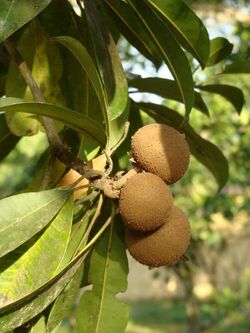Biology:Manilkara huberi
| Manilkara huberi | |
|---|---|

| |
| Scientific classification | |
| Kingdom: | Plantae |
| Clade: | Tracheophytes |
| Clade: | Angiosperms |
| Clade: | Eudicots |
| Clade: | Asterids |
| Order: | Ericales |
| Family: | Sapotaceae |
| Genus: | Manilkara |
| Species: | M. huberi
|
| Binomial name | |
| Manilkara huberi (Ducke) A.Chev.
| |
| Synonyms[1][2] | |
|
Mimusops huberi Ducke | |
Manilkara huberi, also known as masaranduba, níspero, and sapotilla, is a fruit bearing plant of the genus Manilkara of the family Sapotaceae.
Geographical distribution
Manilkara huberi is native to large parts of northern South America, Central America and the Antilles, at elevations below 800 metres (2,600 ft) above sea level.
Description
Manilkara huberi is a large tree, reaching heights of 30–55 metres (98–180 ft). The leaves are oblong, approximately 1–2 decimetres (3.9–7.9 in) in length, with yellow undersides.[3] The flowers are hermaphroditic; white with 3 sepals. The edible fruit is yellow and ovoid,[4] 3 centimetres (1.2 in) in diameter, containing one seed (or occasionally two).
Uses
The fruit of the M. huberi is similar to the sapodilla and is edible, with excellent flavor popular for use in desserts.
M. huberi produces an edible latex that can be harvested in a manner similar to the harvesting of the latex of the rubber tree (Hevea brasiliensis). The latex dries to an inelastic rubber, which is considered inferior to gutta-percha.
The latex from M. huberi is sometimes used to make golf ball covers. It is considered a good, but short-lived, cover, requiring frequent recoating, yet it is popular in tournaments.
The tree is also used for lumber in Puerto Rico. The wood is red and very hard, and is popular for use in furniture making, construction, and railway ties. The wood is so dense to the point that it does not float on water,[citation needed] and requires pre-drilling before nailing. The specific gravity of M. huberi wood is between 0.85 and 0.95 g/cm3.
Synonyms
Manilkara huberi is also known as:[5]
- Manilkara jaimiqui C. Wright ex Griseb.; Dubard
- Mimusops huberi Ducke
- Mimusops jaimiqui C. Wright ex Griseb.
References
- ↑ "Manilkara huberi (Ducke) Standl.". The Trustees of the Royal Botanic Gardens, Kew. n.d.. https://powo.science.kew.org/taxon/urn:lsid:ipni.org:names:152609-2.
- ↑ "Manilkara huberi (Ducke) Standl.". Species 2000. n.d.. https://www.catalogueoflife.org/data/taxon/3XVCF.
- ↑ "Características essenciais das folhas de Manilkara huberi". Espécies Abóreas da Amazônia. Agência de Informação Embrapa. http://dendro.cnptia.embrapa.br/Agencia1/AG01/arvore/AG01_71_309200411814.html. Retrieved 23 July 2012.
- ↑ "Flores de Manilkara huberi". Espécies Abóreas da Amazônia. Agência de Informação Embrapa. http://dendro.cnptia.embrapa.br/Agencia1/AG01/arvore/AG01_67_309200411813.html. Retrieved 23 July 2012.
- ↑ "Manilkara huberi". Tropicos. http://www.tropicos.org/name/28700848?tab=synonyms. Retrieved 23 July 2012.
Wikidata ☰ Q1757926 entry
 |

